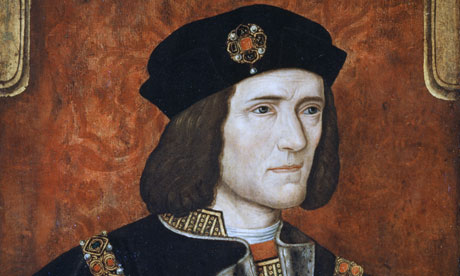BBC News rounds up the details:

A skeleton found beneath a Leicester car park has been confirmed as that of English king Richard III.
Experts from the University of Leicester said DNA from the bones matched that of descendants of the monarch’s family.
Lead archaeologist Richard Buckley, from the University of Leicester, told a press conference to applause: “Beyond reasonable doubt it’s Richard.”
Richard, killed in battle in 1485, will be reinterred in Leicester Cathedral.
Mr Buckley said the bones had been subjected to “rigorous academic study” and had been carbon dated to a period from 1455-1540.
Dr Jo Appleby, an osteo-archaeologist from the university’s School of Archaeology and Ancient History, revealed the bones were of a man in his late 20s or early 30s. Richard was 32 when he died.
Battle wounds
His skeleton had suffered 10 injuries, including eight to the skull, at around the time of death. Two of the skull wounds were potentially fatal.
One was a “slice” removing a flap of bone, the other caused by bladed weapon which went through and hit the opposite side of the skull, a depth of more than 10cms (4ins).
Dr Appleby said: “Both of these injuries would have caused an almost instant loss of consciousness and death would have followed quickly afterwards.
“In the case of the larger wound, if the blade had penetrated 7cm into the brain, which we cannot determine from the bones, death would have been instantaneous.”
Other wounds included slashes or stabs to the face and the side of the head.
Update: New Scientist still has concerns that the trail of evidence is not strong enough to constitute proof of identity:
Mitochondrial DNA is passed down the maternal line and has 16,000 base pairs in total. Typically, you might expect to get 50 to 150 fragments from a 500-year-old skeleton, says Ian Barnes at Royal Holloway, University of London, who was not involved in the research. “You’d want to get sequences from lots of those fragments,” he says. “There’s a possibility of mitochondrial mutations arising in the line from Richard III.”
“It’s intriguing to be sure,” says Mark Thomas at University College London. It is right that they used mitochondrial DNA based on the maternal line, he says, since genealogical evidence for the paternal lineage cannot be trusted.
But mitochondrial DNA is not especially good for pinpointing identity. “I could have the same mitochondrial DNA as Richard III and not be related to him,” says Thomas.
The researchers used the two living descendents to “triangulate” the DNA results. The evidence will rest on whether Ibsen and his cousin have sufficiently rare mtDNA to make it unlikely that they both match the dead king by chance.



